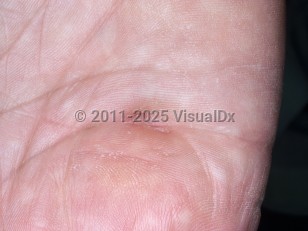Classic history and presentation: Initial symptoms include thickened nodules or plaques (grade 1), which are followed by fibrous band development (grade 2). With progression and increased fibrosis, flexion contractures develop as bands cross the metacarpophalangeal (MCP) and proximal interphalangeal (PIP) joints (grade 3). Patients may also present with similar findings in the plantar fascia (Ledderhose disease). Presentation can be unilateral or bilateral, with one hand typically being more severe than the other.
Prevalence:
- Age of onset – Fifth decade of life in men, sixth to seventh decade of life in women.
- Sex / gender – White men of Northern or Eastern European descent are most commonly affected. 2:1 male predominance.
A small portion of patients with Dupuytren disease also develop Peyronie disease.
Pediatric patient considerations: Rarely the condition can present in pediatric patients, although the clinician should be mindful of epithelioid sarcoma.
Pathophysiology: At present, the pathophysiology of the disorder is not entirely understood, although several factors are believed to contribute to fibroblastic proliferation and altered collagen profiles, including specific platelet-derived fibroblast growth and transforming growth factors.


